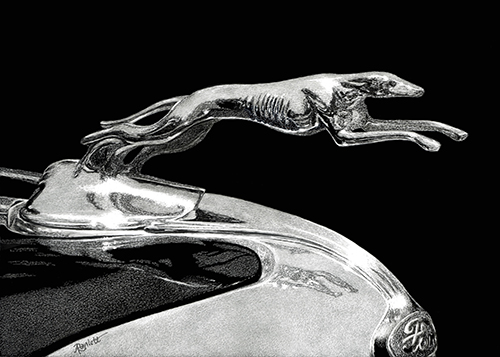Artist Ann Ranlett presents an extraordinary portfolio of detailed animal portraits created in scratchboard. View more of her work on her website.

“Safety” scratchboard, 7″ x 5″
I’ve been drawing since I could hold a crayon. Art has always been a part of my life in some way. For over 20 years, I’ve been a professional artist. That journey began with creating pet portraits for a few friends and it grew from there. I’m mostly self-taught, with a few art classes along the way.

“Steampunk Trickster” scratchboard, 6″ x 6″
My lightbulb moment was taking a scratchboard workshop at an illustrator’s conference in the late 90’s. The instructor was using a professional quality scratchboard. That’s when I learned that scratchboard, on a good surface, is far more forgiving than I expected.

Dog portrait, scratchboard work in progress
Scratchboard has become my medium of choice over the years. My short description of the process is that “I draw white with a knife.” The technique is generally a subtractive method, using a knife (or other abrasive tool) to remove the black ink from the surface to reveal the white clay underneath.

“K9 Ronin” scratchboard 12″ x 9″
However, I work in layers, going back in to add ink with a technical pen to create additional detail and values where needed. That “new ink” is scratched to further refine the detail and values. This method works better for me. Instead of having to be extra precise in scratching, I know I can come back and adjust, so it feels less restrictive.

“Nap Time” scratchboard, 6″ x 6″
Having said that, many of my scratchboard colleagues create the final values as they go, which amazes me. My brain just doesn’t work that way! My drawings are usually too light after the very first pass of scratching, but after many years of doing this, I know to trust the process that I’ve figured out.

“Tucson Yawn” scratchboard, 9″ x 12″
Once the scratching of the entire drawing is as far as I can take it, I add color. Watercolor is my preference, but any transparent water-based medium will work. After adding color, I scratch selectively to fine tune here and there, then re-color selectively. Each layer takes less work overall, so by the time I’m on the last pass— that final “tweaking” pass—I’m scratching and coloring very small portions of the drawing. How do I know when to quit fussing? I know when I’m fidgeting with little marks that no one else will notice, it’s time to call it good.

“Chrome Grace” scratchboard, 5″ x 7″
Most of my drawings are colored, but a few are not. The drawing of the chrome greyhound is one of those, I created all the detail with black, white & shades of grey. While most of the values were created with scratching and re-inking, I used grey ink in a few places. For most drawings, I use color to give the drawing its final “pop.”

“Heart of San Pedro” finished work, scratchboard, 8″ x 8″
I enjoy the challenge and process of creating value, shape, and texture with a knife. Some people, when they watch me demo, call it tedious. I don’t dispute that, believe me, I know scratchboard is not for everyone, but I find it to be far more zen than tedious.

“Any Port for a Nap” scratchboard, 4″ x 4″
I’m honored to be a Master (MSA) member of the International Society of Scratchboard Artists, a Signature member of the Society of Animal Artists, a Signature member of American Women Artists, and an Ampersand Artist Ambassador.
Ann Ranlett invites you to follow on Facebook, Instagram and Rumble.


Speak Your Mind